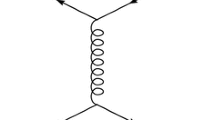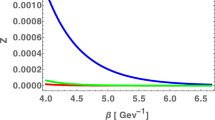Abstract
Trigonometric Rosen–Morse potential is suggested as a quark–antiquark interaction potential for studying thermodynamic properties and masses of heavy and heavy–light mesons. For this purpose, the N-radial Schrödinger equation is analytically solved using an exact-analytical iteration method. The energy eigenvalues and corresponding wave functions are obtained in the N-space. The present results are applied in calculating the mass of mesons such as charmonium c \({\bar{\hbox {c}}}\), bottomonium b \({\bar{\hbox {b}}}\), b \( {\bar{\hbox {c}}}, \) and c \({\bar{\hbox {s}}}\) mesons and thermodynamic properties such as the mean internal energy, the specific heat, the free energy, and the entropy. The effect of dimensional number is studied on the meson properties. The present results are improved in comparison with other recent works and are in good agreement in comparison with experimental data. Thus, the present potential provides satisfied results in comparison with other works and experimental data.






Similar content being viewed by others
References
A.N. Ikot, B.C. Lutfuoglu, M.I. Ngwueke, M.E. Udoh, S. Zare, H. Hassan, Eur. Phys. J. Plus 131, 419 (2016)
M. Abu-Shady, T.A. Abdel-Karim, S.Y. Ezz-Alarab, J. Egypt. Math. Soc. 27, 14 (2019)
A. Suparmi, C. Cari, A.S. Husein, H. Yulian, I.K.A. Khaled, H. Luqman, E. Supriyanto, in 4th International Conference on Advanced Nuclear Science Engineering, vol. 1615, pp. 121–127 (2014)
H. Ciftci, R.L. Hall, N. Saad, J. Phys. A 38, 1147 (2005)
F.M. Fernández, J. Phys. A 37, 6173 (2004)
T. Barak, K. Abod, O.M. Al-Doss, Czechov. J. Phys. 56, 6 (2006)
A. Arda, C. Tezcan, R. Sever, Few Body Syst. 57, 101 (2016)
C.B.C. Jasso, M. Kirchbach, A.I.P. Conf, AIP Conf. Proc. 857, 275–278 (2006)
C.B.C. Jasso, M. Kirchbach, J. Phys. A Math. Gen. 39, 547 (2006)
S. Sharma, Hindawi Publ. Corp. 452978, 26 (2013)
C.V. Sukumar, J. Phys. A Math. Gen. 18, 2917 (1998); AIP Proceedings 744, eds. R. Bijker et al, Supersymmetries in Physics and Applications, 167 (New York, 2005)
F. Cooper, A. Khare, U.P. Sukhat, Super Symmetry Quantum Mechanics (World Scientific, Singapore, 2001)
M. Abu-Shady, T.A. Abdel-Karim, E.M. Khokha, Adv. High Energy Phys. 2018, 7356843 (2018)
M. Abu-Shady, T.A. Abdel-Karim, E.M. Khokha, SF J. Quantum Phys. 2, 1000017 (2018)
M. Abu-Shady, E.M. Khokha, Adv. High Energy Phys. 2018, 7032041 (2018)
M. Tanabashi et al., Phys. Rev. D 98, 030001 (2018)
R. Kumar, F. Chand, Commun. Theor. Phys. 59, 528 (2013)
A. Al-Jamel, H. Widyan, Appl. Phys. Res. 4, 94 (2013)
N.V. Masksimenko, S.M. Kuchin, Russ. Phys. J. 54, 57 (2011)
R. Kumar, F. Chand, Phys. Scr. 85, 055008 (2012)
S.M. Kuchin, N.V. Maksimenko, Univ. J. Phys. Appl. 7, 295 (2013)
A. Kumar Ray, P.C. Vinodkumar, Pramana J. Phys. 66, 958 (2006)
E.J. Eichten, C. Quigg, Phys. Rev. D 49, 5845 (1994)
D. Ebert, R.N. Faustov, V.O. Galkin, Phys. Rev. D 67, 014027 (2003)
Z. Ghalenovi, A.A. Rajabi, S. Qin, H. Rischke. arXiv:hep-ph/14034582 (2014)
C. Patrignani et al., Chin. Phys. C 40, article 100001 (2016)
T. Das, EJTP 13, 207 (2016)
W. Shi-Hal, M. Loz-cass, J.F. Jim-Ngm, A.L. River, Int. J. Quant. Chem. 107, 366–371 (2007)
H. Hassan, M. Hosseinp, Eur. Phys. J. C 76, 553 (2016)
M.H. Pach , R.V. Maluf, C.A.S. Almeid , R.R. Land. arXiv:1406.5114v2 (2014)
E. Meg, E. Ruiz, L.L. Salced. arXiv:1603.04642v3 (2016)
J. Beringer et al., Phys. Rev. D 86, 1 (2012)
W.A. Yah, K.J. Oyew, J. Assoc. Arab. Univ. Basic Appl. Sci. 21, 53 (2016)
M.C. Onyeaj, A.N. Ikot, C.A. Onate, O. Ebomw, M.E. Udoh, J.O.A. Idiod, Eur. Phys. J. Plus. 132, 302 (2017)
S. Roy, D.K. Choudhury, Can. J. Phys. 94, 1282 (2016)
Author information
Authors and Affiliations
Corresponding author
Additional information
Publisher's Note
Springer Nature remains neutral with regard to jurisdictional claims in published maps and institutional affiliations.
Appendix A
Appendix A
In this appendix, thermodynamics properties of the Trigonometric Rosen–Morse potential are studied, the partition function is given \(\hbox {Z}=\mathop \sum \nolimits _{n=0}^\infty e^{-\beta E}\), where \(\upbeta = \frac{1}{K T}\), K is the Boltzmann constant as in Ref. [1]
1.1 Partition function
by substituting Eq. (28), we obtain
where,
1.2 Mean energy U
1.3 Specific heat C
1.4 Free energy
1.5 Entropy
Rights and permissions
About this article
Cite this article
Abu-Shady, M., Ezz-Alarab, S.Y. Trigonometric Rosen–Morse Potential as a Quark–Antiquark Interaction Potential for Meson Properties in the Non-relativistic Quark Model Using EAIM. Few-Body Syst 60, 66 (2019). https://doi.org/10.1007/s00601-019-1531-y
Received:
Accepted:
Published:
DOI: https://doi.org/10.1007/s00601-019-1531-y




